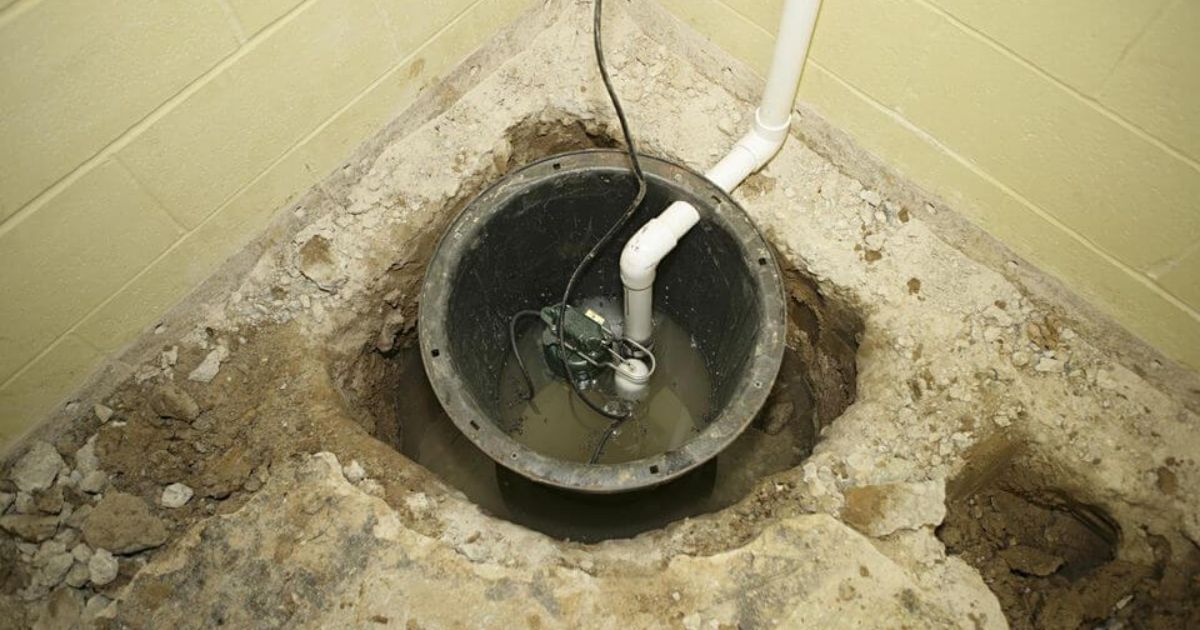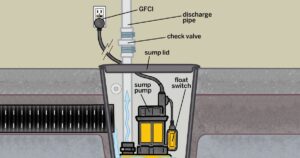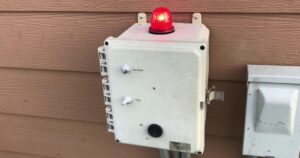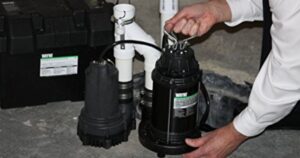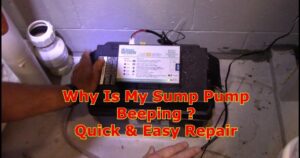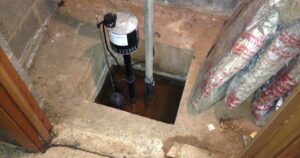In the realm of finished basements, the sump pump can often feel like an intrusive presence, disrupting the seamless harmony of the space. However, fear not, as this article serves as a guiding light, illuminating the path to successfully hide and integrate the sump pump into your basement’s design. With a range of techniques, from building custom enclosures to incorporating the pump into decorative features, you can achieve a cohesive and aesthetically pleasing environment that seamlessly conceals this essential yet unsightly apparatus.
Key Takeaways
- Consider accessibility and ease of maintenance when choosing a hiding location for the sump pump
- Ensure the sump pump is concealed in a way that blends seamlessly with the overall aesthetics of the finished basement
- Explore options such as custom enclosures, decorative features, and furniture or shelving to hide the sump pump
-
Maintain accessibility and safety precautions by regularly inspecting and maintaining the sump pump, implementing safety features, and keeping the area clean and clutter-free. It’s also important to address the question, “Is sump pump smell toxic?” to ensure that any unusual odors are investigated promptly for potential health hazards.
Evaluate the Sump Pump Location

Evaluating the sump pump location is crucial in ensuring proper concealment in a finished basement. The sump pump is an essential component of any basement waterproofing system, but it can be an eyesore if not properly hidden. When evaluating the location, consider accessibility, noise levels, and aesthetics. It is important to choose a location that allows easy access for maintenance and repairs. Additionally, the sump pump should be placed in an area where the noise it generates will not be disruptive to the living space above. Lastly, consider the overall aesthetics of the basement. The sump pump should be concealed in a way that blends seamlessly with the rest of the finished space. This could involve using decorative covers or building a custom enclosure to hide the pump. By carefully evaluating the sump pump location, you can ensure that it remains concealed while still being functional and accessible.
Choose a Suitable Hiding Method
To effectively conceal a sump pump in a finished basement, it is important to carefully consider and select an appropriate hiding method. There are several options available, depending on the layout and design of your basement. One common method is to build a custom enclosure around the sump pump. This can be done using materials that match the aesthetics of your basement, such as wood or drywall. Another option is to incorporate the sump pump into a functional piece of furniture, such as a storage cabinet or a built-in shelf. This not only hides the pump but also maximizes the use of space in your basement. Additionally, you can consider using decorative screens or curtains to conceal the sump pump while still allowing easy access for maintenance. Remember to choose a hiding method that complements the overall design of your finished basement.
Build a Custom Enclosure
One effective method to conceal a sump pump in a finished basement is by constructing a custom enclosure. Building a custom enclosure allows you to tailor the design to match the overall aesthetic of your basement and make it blend seamlessly with the surrounding decor. Start by measuring the dimensions of the sump pump and the space it occupies, ensuring that the enclosure will fit properly. Next, choose a suitable material such as wood or PVC for the construction of the enclosure. Consider adding ventilation holes or a removable panel for easy access and maintenance. Once the enclosure is built, you can paint or stain it to match the color scheme of the basement. By building a custom enclosure, you can effectively hide the sump pump while maintaining the cohesive look and feel of your finished basement.
To take the concealment of your sump pump to the next level, you can incorporate it into a decorative feature.
Incorporate the Sump Pump Into a Decorative Feature

A creative approach to concealing the sump pump in a finished basement is by integrating it into a decorative feature. This not only hides the pump but also adds aesthetic value to the space. One option is to build a custom enclosure around the sump pump and incorporate it into a larger decorative structure, such as a faux stone column or a built-in bookshelf. Another idea is to use a decorative screen or room divider to hide the pump while adding a stylish element to the room. By incorporating the sump pump into a decorative feature, you can seamlessly blend it into the overall design of your finished basement, creating a space that is both functional and visually appealing. In the next section, we will explore how furniture or shelving can be used to further conceal the sump pump.
Use Furniture or Shelving to Conceal the Sump Pump
To further camouflage the sump pump in a finished basement, consider utilizing furniture or shelving as a practical and stylish solution. By strategically placing furniture or shelving units around the sump pump area, you can effectively hide it from sight while also adding functionality and aesthetic appeal to the space. Choose furniture pieces or shelving units that complement the overall style and design of your basement, ensuring a seamless integration. For example, you can use a bookshelf or a storage cabinet to create a barrier around the sump pump, effectively concealing it from view. Additionally, you can use decorative items such as vases, plants, or artwork to further distract attention from the sump pump. Remember to leave sufficient access to the sump pump for maintenance purposes. With the right furniture or shelving arrangement, you can successfully hide the sump pump while enhancing the overall ambiance of your finished basement.
Maintain Accessibility and Safety Precautions
To ensure ongoing functionality and safety, it is essential to consistently maintain accessibility and implement necessary safety precautions when concealing a sump pump in a finished basement. Accessibility is crucial to ensure that the sump pump can be easily accessed for inspection, maintenance, and repairs when needed. When hiding the sump pump, ensure that it is easily accessible by leaving enough space around it and avoiding any obstructions. Additionally, it is important to regularly inspect the sump pump and its components for any signs of damage or malfunction. This includes checking the float switch, discharge pipe, and pump motor for any issues. Implementing safety precautions such as installing a battery backup system and a high-water alarm can provide added protection in case of power outages or pump failures. Regularly testing these safety features is also necessary to ensure their proper functioning. By maintaining accessibility and implementing safety precautions, you can ensure the longevity and effectiveness of your concealed sump pump while keeping your finished basement safe and dry.
Frequently Asked Questions
How Much Does It Typically Cost to Build a Custom Enclosure for a Sump Pump?
The cost of building a custom enclosure for a sump pump can vary depending on factors such as materials used, design complexity, and labor costs. It is advisable to consult with professionals in order to obtain accurate estimates.
Can I Use Any Type of Furniture or Shelving to Conceal the Sump Pump?
When concealing a sump pump in a finished basement, it is important to consider the type of furniture or shelving that can be used. Certain furniture or shelving options may be suitable for hiding the sump pump effectively.
Are There Any Specific Safety Precautions I Need to Take When Hiding a Sump Pump?
When concealing a sump pump in a finished basement, it is crucial to prioritize safety precautions. Adequate ventilation, access for maintenance, and compliance with local building codes should be considered to ensure the proper functioning of the pump and the well-being of occupants.
Can I Relocate My Sump Pump to a Different Area of the Basement?
Relocating a sump pump in a finished basement can be a viable option, depending on the specific circumstances. However, it is crucial to consider factors such as the plumbing layout, accessibility, and potential impact on the pump’s functionality and performance.
How Often Should I Check and Maintain the Sump Pump for Optimal Functionality?
To ensure optimal functionality, it is recommended to check and maintain the sump pump regularly. This includes inspecting the pump for any signs of damage, cleaning the pump and pit, and testing the pump’s operation. Regular maintenance will help prevent potential issues and ensure the pump is ready to handle any water infiltration.
Conclusion
In conclusion, hiding a sump pump in a finished basement can be achieved through various methods such as building a custom enclosure, incorporating it into a decorative feature, or using furniture or shelving to conceal it. It is important to prioritize accessibility and safety precautions when implementing these hiding techniques. With careful planning and creativity, you can successfully disguise your sump pump while maintaining the functionality and aesthetics of your basement space.
